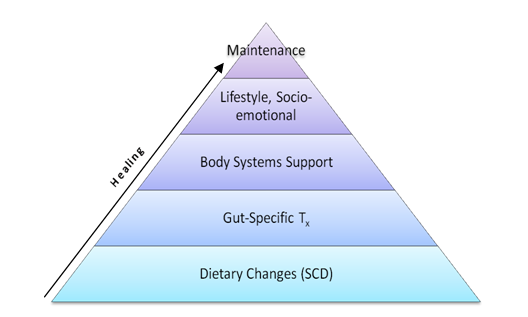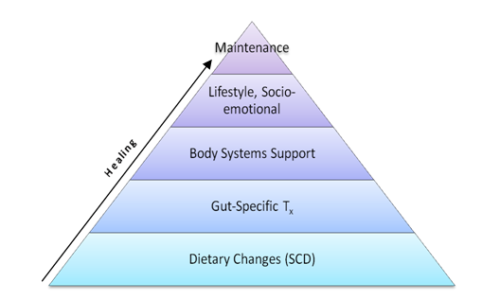The Big Picture: Setting Healing Goals

Sometimes when I look down and notice a bug in the lush grass, time slows down. Next thing I know I’m deep in contemplation on the trees, and the scene around me. It’s easy to get lost in the beauty of a forest.
It’s just as easy when your belly hurts to get lost in your head, the internet and books, except this kind of lost doesn’t usually calm us down.
It’s in these darkest hours, when the Google death spiral consumes us that we need perspective the most. Having perspective on where you’re going, why you’re doing what you’re doing, and that you’re not alone is very important. Unfortunately, many times it’s hard to take the steps when your tummy is hurting or colon is bleeding.
It’s one of the essentials for long-term healing. And that’s the tragedy… the people who fail to think with perspective and plan are likely to never get well. That’s why we are really happy Matt is back to help us all gain some awareness and perspective on proactive health planning.
This is a guest post series from Matt Robinson, digestive illness coach at Natural Digestive Healing.
One of my personal goals for this series (and in writing and coaching in general) is to share some of the tools that I have developed over the years in the hope that they may speed your healing, and save you anguish along the way. Getting to the place where I could write a series like this has been a struggle. I have had some wonderful successes (like the SCD), and I have had some miserable failures. It has taken a tremendous amount of trial and error, of searching out experts, of reading books and studies, blogs and chat forums, to get my gut under control. Writing this series in hindsight, I hope, will help minimize some of that for you.
In my last post, I discussed the value of a big picture outlook and introduced the concepts of balance and prioritization as they relate to healing from digestive illness. In this post, I will expand on those concepts and walk you through the first steps of developing a big picture-focused healing plan. If you are using this series to its fullest, remember to get out a pen and paper, so you will be ready to jot down ideas and think about the questions and concepts along the way.
To be sure, having a healing plan does not guarantee that you will heal. There are no guarantees with digestive illness, and there are many days when I wonder, “Will I ever be free of this?” Having a plan is essential to healing, and is especially helpful in those moments of doubt, frustration, and fear. It helps you to:
- Map a path to follow. With a map in hand, it is more difficult to get lost, waylaid, or sidetracked—all of which will slow or stop your healing.
- Create a vision. A big picture healing plan keeps the goal in front of you. The best way to achieve a big goal like healing from digestive illness is to have a powerful vision, and to use it to create a roadmap that gets you there.
- Create a structure for learning about your condition, and help form the container into which you fit all of the ideas and treatments you want to try. Adding new treatments willy-nilly is the best way to decrease your chances of healing. So, when you see a new treatment, or hear of a new diet tweak, go back to your big picture healing plan and ask, “Where does this fit on my roadmap?” If it does not fit, file it away for later. If it needs to fit, then rework your plan, but make sure whatever you are adding betters your plan and fits your goals.
Writing Your Go-sion
What in the world is a go-sion? I’ll get to that in a moment.
Last time, I asked you to envision your life once your ultimate healing goal has been achieved. If you did that, take a second to remember what you saw and how you felt; try on that life again for a moment…
If you did not do that, or if you are just catching this series, I challenge you to pause right here and do that. Dare to envision a fully healed life. Here are the questions I posed last time, as a guide:
What is your ultimate health and healing goal? Pause for a moment and picture it. What is life like once this goal has been achieved? What are you doing? How do you feel? What have you learned along the way? Take some time to experience it…
Now that your goal is fresh in your mind, we can use what you just envisioned to create a go-sion. A “go-sion,” as I call it, is a vision and goal in one. A vision is inspiring and captures the essence of the venture. A goal is concrete and achievable. In healing from chronic illness, I find it is easier and more helpful to write vision and goals together as a visionary goal, a go-sion.
Your go-sion should embody your ultimate end state, where you are content with your health. It should also be specific and measurable. That is, you should be able to tell when you get there that you have achieved your goal. It should also be inspiring and capture your heart. Let me give you mine as an example.
My big picture healing go-sion says this, “I want to be inflammation free.” It is a simple, succinct, powerful statement that reminds me why I strive and struggle daily against colitis. For me the clause, Inflammation Free, embodies my dreams of growing old with my wife, of backpacking with my children, of living with energy, zest, and ebullience. To me “Inflammation Free” is both measurable and inspiring. It is my go-sion. Making it rhyme is a bit silly, but helps me to remember it more easily.
Notice that my go-sion is BIG. Even though I would like to be able to eat a bar of chocolate without gut problems, that is not a visionary goal—it is not a go-sion. It may be an appropriate measure to let me know I am close to my goal; it may even be a fitting progress goal, but it is not a visionary goal. In creating your go-sion, think big picture.
Putting pen to paper and writing your go-sion statement is essential. It’s not enough to just know it in your head. Writing it will clarify and solidify your statement.
Review and Remember: What is your go-sion? Where would you like to get to? Write this down and put it in a place where you will see it every day.
Using Balance and Prioritization to Set SMART Goals
Now that you have a go-sion, you can set progress goals. In setting goals, you want to ensure that each goal is Specific, Measurable, Achievable, Relevant and Timely. [1]
As you create your goals, remember:
- Location: You are in the perfect place right now to set healing goals and begin working towards them.
Think about: What are some obstacles in your life that keep you from setting healing goals and working towards them? How will you overcome those obstacles?
- Commitment: Full commitment is masterful. 99% commitment never achieved a goal.
Think about: Am I committed to my go-sion? As you lay out your go-sion and SMART goals, ask, “Am I committed, really committed? What are my obstacles to commitment? What will it take for me to commit to just the first goal (to start the SCD, for example)? Who will hold me accountable, for instance, to staying on the SCD when I have the 3-month flare, or during the holidays when all I want is a big fat hunk of chocolate?”
- Perseverance: Healing from digestive illness takes work. That work can be fun, and it will change your life; it has changed mine. I am a better man now having struggled with colitis than I was before. This work is also often frustrating, thankless, and difficult. Stick with it; the reward can be invaluable.
Think about: Accountability, transparency, and community are keys to perseverance. How will you ensure these elements are a ubiquitous part of your life?
- Community: DIYers, Independent souls, I’m talking to you. There is no shame in your illness, no guilt in needing (or wanting) help. Gather around you a group of people who will support you in your journey. These are people who will always tell you the truth, and who will hold you accountable to your goals; friends, family, medical professionals, coaches, your childhood teddy bear. Be thoughtful about this one, because no one can tow this road alone.
Think about: Do you have a good support community around you? If you do, how will you encourage and thank them for the role they play in your life? If you do not, what steps do you need to take to build that community?
Writing Your Goals
Okay, enough of the soft stuff. It is time to get into the details of using your go-sion to set SMART healing goals. I’ll use my experience as an example, and we can set these goals together.
Remember my go-sion? “I want to be inflammation free.”
In developing goals, it is important to apply the concepts of Balance and Prioritization from the previous post. Balance the urgent with the important; care for your short-term needs. Of the urgent, ask yourself, “Are these needs or desires?” Plan and create space for your long-term healing.
In late 2008, when I was starting to make my healing plan and goals, one of the first questions I asked was, “How was I going to get from 24 bloody bowel movements per day, and ‘severe colitis throughout’ my colon (as my doctor described it) to no inflammation and 1-2 formed comfortable movements per day? And how would I know I was moving in the right direction?” I needed some goals.
Here are just a few that I set for myself as examples. Notice that they are Specific (clear, understandable), Measurable, Achievable (realistic, but a bit ambitious), Relevant (to healing) and Timely (set in appropriate order—I cannot run a marathon until I have fewer BMs).
A note on Timely goals: Notice that my healing goals are timely and not time-bound. As much as we would like, we cannot control or predict the amount of time it will take to heal or to reach a healing goal. This is embodied in number two in my list of Big Picture Outlook traits: “Make Peace with Uncertainty.” Strapping yourself with time-bound healing goals for your body will only add stress and frustration to your healing journey.
(A Few of) My Goals
- Start the SCD by May 1st, 2009, and complete the first 90 days without cheating (something I can control).
- Wean off prednisone (up to my body).
- Get down to four bowel movements per day (again, up to my body).
- Tell my wife something I am thankful for, each day (attitude is half the battle).
- Run a trail marathon (embodies goals 1-4).
Each of these goals represents a milestone I wanted to reach in my healing journey. They are just a sample of the goals I have set for myself in the past four years. Sure, I have made mistakes along the way. Certainly you will too. I have had almost four years to revise and track my goals. Your goals sheet and healing plan is a living document, so be open to revision; dream, and have fun with these—they will be your guide, your cairns on a long and winding road.
Think about: Set 3-5 shorter-term healing goals for yourself. Include at least one you can start today. Ask yourself, “Are these achievable? What do I need to do to achieve these goals?” Once you have set those goals, think about longer-range goals. What might those look like? Write them down too, knowing they can change.
Prioritizing Your Goals
Once you have sketched some goals, you can prioritize them. Prioritize first those goals which give you early success. Choose things you can do, you can control. For me, it was to start the SCD. I could do that no matter how I felt. It was completely under my control. Build the momentum. Then, prioritize your other goals. As you do so, you should start to get an idea, an outline of what your healing plan should look like.
As you begin to think about your healing plan remember: healing from illness is tough. It happens in layers, and layering healing modalities in order of efficacy can speed your healing. Remember this pyramid below? This pyramid is the container which I use to hold all of my healing ideas. It tells me what to add and when, the relative efficacy of each healing protocol, and helps me put it into my plan.
As you start prioritizing your goals, and begin to add natural healing modalities, think about which of those modalities will have the largest effect, and try those first. Pick the low-hanging fruit first and you will increase your chances of early success. These early wins are important to building long-term momentum that will keep you on the narrow path to healing.
It is important for me to be clear: There is no canned approach that will bring everyone healing. That pyramid is just my representation of what I have seen work, and it embodies the credible literature and approaches I have read and experienced.
That said, I am convinced that dietary changes for treating digestive illness are the foundation of any good healing program. Whether it is the SCD, GAPS, an elimination, or another diet, what you eat has the ability to make or break your healing experience.
Next, gut-specific treatments like probiotics, enzymes, HCl, Fecal Transplants, butyrate enemas, etc., affect the same system and problems as diet: your damaged gut and gut flora. Your gut flora is the keystone of a healthy life, and the right combination of diet and other gut-specific healing protocols are the best way to begin to reset that keystone.
Developing a visionary goal, setting SMART progress goals, and layering healing protocols in an ordered, effective manner (waiting for each to have its full effect before moving on) will help to ensure your healing path is as straight and smooth as possible.
Now that you have a go-sion and some goals to work with, we will go into more detail next time about setting a healing plan. I will walk you through my big picture healing plan, and we can frame your own plan together along the way.
Onward to Health,
-Matt
Matt Robinson is a digestive illness coach. He helps people with digestive illness to optimize their healing path. He was diagnosed with ulcerative colitis in 2002, and has been living medication-free since early 2009. You can read more articles like this one, or schedule a free coaching session at his website: www.naturaldigestivehealing.com
[1] Meyer, Paul J (2003). “What would you do if you knew you couldn’t fail? Creating S.M.A.R.T. Goals”. Attitude Is Everything: If You Want to Succeed Above and Beyond. Meyer Resource Group, Incorporated, The. ISBN 978-0-89811-304-4.
[FYI – Yes, we will make a small commission off the amazon link above… but you probably already knew that. We don’t want to insult your intelligence, but need you to be aware of this. Thanks for the donation.]
Did You Like this Article?
Subscribe to our newsletter to receive email notifications, some ways to find relief, and next steps.


